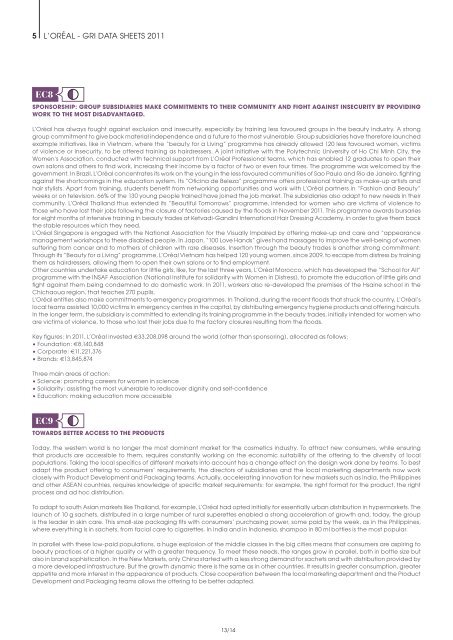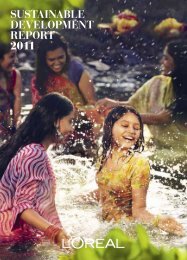Organizational Strategy - Sustainable Development - L'Oréal
Organizational Strategy - Sustainable Development - L'Oréal
Organizational Strategy - Sustainable Development - L'Oréal
You also want an ePaper? Increase the reach of your titles
YUMPU automatically turns print PDFs into web optimized ePapers that Google loves.
5 L’oréaL - GrI DaTa SHEETS 2011<br />
EC8<br />
sPONsORsHIP: GROUP sUbsIDIaRIes MaKe COMMITMeNTs TO THeIR COMMUNITY aND FIGHT aGaINsT INseCURITY bY PROVIDING<br />
WORK TO THe MOsT DIsaDVaNTaGeD.<br />
L’oréal has always fought against exclusion and insecurity, especially by training less favoured groups in the beauty industry. a strong<br />
group commitment to give back material independence and a future to the most vulnerable. Group subsidiaries have therefore launched<br />
example initiatives, like in Vietnam, where the “beauty for a Living” programme has already allowed 120 less favoured women, victims<br />
of violence or insecurity, to be offered training as hairdressers. a joint initiative with the Polytechnic University of Ho Chi Minh City, the<br />
Women’s association, conducted with technical support from L’oréal Professional teams, which has enabled 12 graduates to open their<br />
own salons and others to find work, increasing their income by a factor of two or even four times. The programme was welcomed by the<br />
government. In Brazil, L’oréal concentrates its work on the young in the less favoured communities of Sao Paulo and rio de Janeiro, fighting<br />
against the shortcomings in the education system. Its “oficina de Beleza” programme offers professional training as make-up artists and<br />
hair stylists. apart from training, students benefit from networking opportunities and work with L’oréal partners in “Fashion and Beauty”<br />
weeks or on television. 66% of the 130 young people trained have joined the job market. The subsidiaries also adapt to new needs in their<br />
community. L’oréal Thailand thus extended its “Beautiful Tomorrows” programme, intended for women who are victims of violence to<br />
those who have lost their jobs following the closure of factories caused by the floods in November 2011. This programme awards bursaries<br />
for eight months of intensive training in beauty trades at Ketvadi-Gandini International Hair Dressing academy, in order to give them back<br />
the stable resources which they need.<br />
L’oréal Singapore is engaged with the National association for the Visually Impaired by offering make-up and care and “appearance<br />
management workshops to these disabled people. In Japan, “100 Love Hands” gives hand massages to improve the well-being of women<br />
suffering from cancer and to mothers of children with rare diseases. Insertion through the beauty trades is another strong commitment:<br />
Through its “Beauty for a Living” programme, L’oréal Vietnam has helped 120 young women, since 2009, to escape from distress by training<br />
them as hairdressers, allowing them to open their own salons or to find employment.<br />
other countries undertake education for little girls, like, for the last three years, L’oréal Morocco, which has developed the “School for all”<br />
programme with the INSaF association (National Institute for solidarity with Women in Distress), to promote the education of little girls and<br />
fight against them being condemned to do domestic work. In 2011, workers also re-developed the premises of the Hsaine school in the<br />
Chichaoua region, that teaches 270 pupils.<br />
L’oréal entities also make commitments to emergency programmes. In Thailand, during the recent floods that struck the country, L’oréal’s<br />
local teams assisted 10,000 victims in emergency centres in the capital, by distributing emergency hygiene products and offering haircuts.<br />
In the longer term, the subsidiary is committed to extending its training programme in the beauty trades, initially intended for women who<br />
are victims of violence, to those who lost their jobs due to the factory closures resulting from the floods.<br />
Key figures: In 2011, L’oréal invested €33,208,098 around the world (other than sponsoring), allocated as follows:<br />
• Foundation: €8,140,848<br />
• Corporate: €11,221,376<br />
• Brands: €13,845,874<br />
Three main areas of action:<br />
• Science: promoting careers for women in science<br />
• Solidarity: assisting the most vulnerable to rediscover dignity and self-confidence<br />
• Education: making education more accessible<br />
EC9<br />
TOWaRDs beTTeR aCCess TO THe PRODUCTs<br />
Today, the western world is no longer the most dominant market for the cosmetics industry. To attract new consumers, while ensuring<br />
that products are accessible to them, requires constantly working on the economic suitability of the offering to the diversity of local<br />
populations. Taking the local specifics of different markets into account has a change effect on the design work done by teams. To best<br />
adapt the product offering to consumers’ requirements, the directors of subsidiaries and the local marketing departments now work<br />
closely with Product <strong>Development</strong> and Packaging teams. actually, accelerating innovation for new markets such as India, the Philippines<br />
and other aSEaN countries, requires knowledge of specific market requirements: for example, the right format for the product, the right<br />
process and ad hoc distribution.<br />
To adapt to south asian markets like Thailand, for example, L’oréal had opted initially for essentially urban distribution in hypermarkets. The<br />
launch of 10 g sachets, distributed in a large number of rural superettes enabled a strong acceleration of growth and, today, the group<br />
is the leader in skin care. This small-size packaging fits with consumers’ purchasing power, some paid by the week, as in the Philippines,<br />
where everything is in sachets, from facial care to cigarettes. In India and in Indonesia, shampoo in 80 ml bottles is the most popular.<br />
In parallel with these low-paid populations, a huge explosion of the middle classes in the big cities means that consumers are aspiring to<br />
beauty practices of a higher quality or with a greater frequency. To meet these needs, the ranges grow in parallel, both in bottle size but<br />
also in brand sophistication. In the New Markets, only China started with a less strong demand for sachets and with distribution provided by<br />
a more developed infrastructure. But the growth dynamic there is the same as in other countries. It results in greater consumption, greater<br />
appetite and more interest in the appearance of products. Close cooperation between the local marketing department and the Product<br />
<strong>Development</strong> and Packaging teams allows the offering to be better adapted.<br />
13/14






